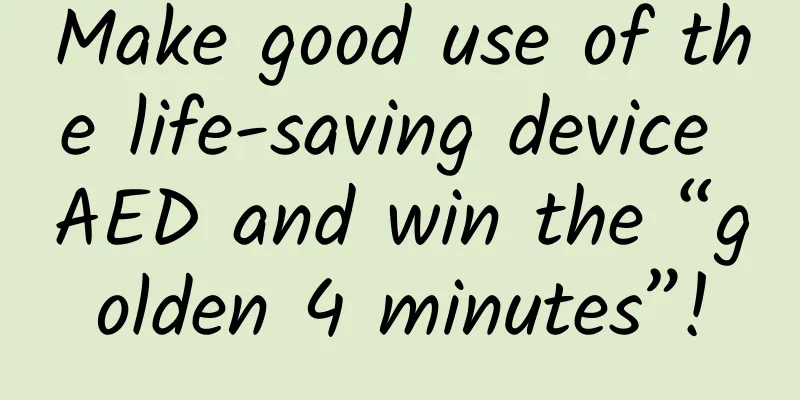Make good use of the life-saving device AED and win the “golden 4 minutes”!

|
With the development and progress of society, many cities have begun to equip AED, but many people still don't know what it is. If you or your family suddenly collapses in a public place due to cardiovascular disease, it may be able to save a life from a few dozen meters away. In order to help everyone better understand AED, we specially invited Li Jianhua, chief physician of the Cardiac Surgery Center of Beijing Anzhen Hospital Affiliated to Capital Medical University, to give relevant answers. 1. The incidence of out-of-hospital cardiac arrest, including sudden cardiac death, remains high 1. What is sudden cardiac death? Sudden cardiac death is a disease with multiple causes and risk factors. Under the influence of various reasons, the heart can cause a healthy person to die suddenly. It is most common in adults under 65 years old, with male patients being 2-3 times more likely than female patients, and the incidence rate increases significantly in winter and spring. Statistics show that among patients who died from cardiovascular disease, about 60% died of sudden cardiac death. It is estimated that about 100,000 to 400,000 patients die of sudden cardiac death each year in the United States. Currently, the number of sudden cardiac deaths is still increasing due to the increase in the number of patients with diabetes, coronary heart disease, hypertension, etc. According to statistics, the incidence of sudden cardiac death in my country is about 0.04%. Although it is lower than that in the United States and other Western countries, due to the large population base, the number of deaths caused by sudden cardiac death is higher than that in Western countries, and the total number of sudden cardiac deaths ranks first in the world. 2. There are many causes of sudden cardiac death. Sudden cardiac death can occur in people with underlying heart disease or in people without heart disease. There are usually no obvious signs of sudden cardiac death (some patients have chest pain symptoms), and sudden loss of consciousness is its main feature. Patients die suddenly within 1 hour after the onset of acute symptoms such as sudden loss of consciousness, cardiac arrest, and respiratory arrest. The onset of sudden cardiac death is related to a variety of risk factors, such as acute myocardial ischemia, arrhythmia, structural heart defects, congenital heart disease, primary cardiomyopathy, etc. It should be noted that coronary heart disease is an important risk factor for sudden cardiac death. Age (>55 years old), male gender, smoking history, hypertension, diabetes, hyperlipidemia, obesity, coronary heart disease and unhealthy lifestyle are confirmed risk factors for sudden cardiac death. 3. Failure to provide timely rescue increases the number of sudden cardiac deaths About 90% of sudden cardiac deaths in my country occur each year in public places such as stations and subways, but the success rate of rescue is less than 1%, while in other countries this figure can reach 15%. Normally, 4 minutes after cardiac arrest, brain cells will be irreversibly damaged due to lack of oxygen, so the golden rescue time for cardiac arrest caused by sudden cardiac death is only 3-5 minutes. However, since sudden cardiac death often occurs outside of hospitals, ambulances and professional rescue personnel often cannot arrive at the scene in time during this period of time. If AED equipment is used correctly, it can greatly improve the effect of first aid and save lives. 2. Why does AED arouse discussion among netizens? 1. What is AED? AED, or automated external defibrillator, is also known as a fool-proof defibrillator. It is a portable Class III medical device that can be used by non-professional medical personnel. It can be used to rescue cardiac arrest caused by ventricular fibrillation and pulseless ventricular tachycardia. It can automatically identify abnormal heart rate and perform external defibrillation in time to restore the normal heartbeat. Generally, after a few hours of training, non-medical personnel can learn how to operate AED equipment. Compared with cardiopulmonary resuscitation (CPR), its operation method is simpler and easier to learn. The automatic external defibrillator will determine whether the patient needs electric shock defibrillation based on the specific electrocardiogram conditions. At present, the types of automatic external defibrillators equipped in public places include fully automatic models and semi-automatic models. After the rescuer puts the electric shock patch on the patient, the fully automatic external defibrillator can make a judgment and produce an electric shock. During use, the semi-automatic external defibrillator will remind the rescuer to press the electric shock button to perform the defibrillation operation. 2. Will incorrect operation cause secondary harm to the patient? Many people worry that if they accidentally shock the patient, it will cause secondary injury. In fact, even if the rescuer presses the shock button by mistake, if the patient does not meet the conditions for defibrillation, the automatic defibrillator will not shock the patient. 3. Why is AED called a “life-saving device”? Every year, there are 2.5 million patients in my country who suffer from sudden cardiac death and other causes of cardiac arrest. The main problem is that on the one hand, there are a large number of people suffering from cardiac arrest, and on the other hand, the success rate of out-of-hospital rescue for patients with cardiac arrest is extremely low. At present, the success rate of out-of-hospital rescue for cardiac arrest in my country is about 1%, while the success rate of rescue in developed countries in Europe and the United States can reach 10%-30%. According to statistics, for every additional minute of cardiac arrest, the patient's chance of survival decreases by 7%-10%. More than 90% of patients will experience certain types of arrhythmias such as ventricular fibrillation before cardiac arrest. If a patient with cardiac arrest can receive cardiopulmonary resuscitation and artificial respiration within 1 minute, and AED defibrillation within 3-5 minutes, the survival rate of the patient with cardiac arrest can reach 50%-70%. The use of an automated external defibrillator is also currently recognized as an effective method for pre-hospital control of sudden cardiac death. The success rate of rescuing patients with cardiac arrest with the use of an automated external defibrillator is significantly higher than that of simple manual cardiopulmonary resuscitation. Due to the advantages of an automated external defibrillator, such as small size, light weight, easy to carry, safe to use, and simple to operate, it is also called a "life-saving artifact." 4. In what situations should AED equipment be used? The vast majority of sudden cardiac deaths are caused by cardiac arrest due to ventricular fibrillation, and AED devices are devices that restore the rhythmic beating of the heart through electric shock defibrillation. Therefore, the use of automatic external defibrillators and cardiopulmonary resuscitation are only applicable to those who have sudden cardiac death or cardiac arrest caused by other reasons. How to determine whether a patient is experiencing cardiac arrest? To determine whether a patient has suffered cardiac arrest, pay attention to the following three characteristics: 1. Loss of consciousness The patient suddenly lost consciousness. No response was seen when the patient was patted and shaken on the shoulders and called out to. 2. Disappearance of carotid artery pulsation The disappearance of large artery pulsation is the main feature of cardiac arrest, which can be judged through the carotid artery and femoral artery. Since the carotid artery is easy to find, the disappearance of carotid artery pulsation is usually used as the judgment standard. Carotid artery location: Place your index finger and middle finger together, slide them to one side and touch the depression next to the Adam's apple to feel the carotid artery. The general inspection time is 5 seconds, and no second inspection is performed. If it is determined that the carotid artery pulse has disappeared, cardiopulmonary resuscitation or external defibrillation should be performed immediately. 3. Respiratory arrest Place your ear against the patient's mouth and nose and observe whether the patient's chest rises and falls. You can also place cotton or feathers against the patient's nostrils to determine whether there is any gas exhaled. It should be noted that if the patient suddenly loses consciousness, first shout for help, ask people around you to call the emergency number, and try to get an AED device. Once it is confirmed that the carotid pulse has disappeared, regardless of whether the patient is breathing, cardiopulmonary resuscitation should be performed immediately, or an automatic external defibrillator should be used for defibrillation. If it is not certain whether the carotid pulse has disappeared, and the patient suddenly loses consciousness and stops breathing, cardiopulmonary resuscitation should also be performed in time. 5. How should the “life-saving artifact” be used correctly? Before using an automated external defibrillator, make sure the patient's current environment is safe to avoid secondary injury. The use of an automated external defibrillator mainly includes the following five operating points: 1. Turn on the automatic external defibrillator Turn on the AED power (due to different brands, some AED devices need to press the power button to turn on, and some AED devices will automatically turn on when the lid is opened). After the device is turned on, it will issue a voice prompt. Perform subsequent operations according to the voice prompt. 2. Connect the patch Attach electrodes to the patient. The device comes with two electrodes. The electrodes should be attached to the patient's left breast and upper right chest (right clavicle lower side) respectively. The specific positions can refer to the pattern on the AED device shell or the picture instructions on the electrodes. Note that the electrodes should fit the patient's skin closely. Reminder: If the patient's chest skin is wet, wipe it clean before applying the electrode. Be careful to avoid wounds and implants (such as pacemakers). 3. Plug the motor cable into the corresponding socket of the AED device as prompted. 4. Take your hands off the patient and the AED device will automatically analyze the heart rhythm Press the "Analyze" button and the AED device will start analyzing the heart rhythm, which takes 5-15 seconds. During the heart rhythm analysis process, be sure not to touch the patient to avoid affecting the analysis results of the AED device. After the analysis is completed, if the AED device prompts that defibrillation is needed, the "defibrillation" button should be pressed immediately, and the AED device will automatically perform defibrillation. At this time, the device will prompt people nearby to stay away from the patient. At present, some AED devices will automatically defibrillate after analyzing the heart rhythm, without the rescuer having to press the defibrillation button. 5. Cooperate with cardiopulmonary resuscitation After defibrillation, the AED device will analyze the heart rhythm again. If the patient does not recover effective heart beats after one defibrillation, 5 cycles of cardiopulmonary resuscitation should be performed immediately, with 2 artificial respirations plus 30 chest compressions as one cycle. Continue to repeat the operation of analyzing heart rhythm-defibrillation-cardiopulmonary resuscitation. If the AED device analyzes that defibrillation is not needed, cardiopulmonary resuscitation should be performed until emergency personnel arrive at the scene. It should be noted that if an AED device is available immediately, it should be used for defibrillation first, followed by cardiopulmonary resuscitation. Do not remove or turn off the AED device before professional emergency personnel arrive at the scene. 6. Is AED safe during use? Many people are concerned about one issue: Is it safe to use an AED device for rescue? If the patient is injured during the rescue process, will there be any risks? In fact, AED equipment is a very safe medical device. During the rescue process, the AED equipment will automatically analyze the patient's heart rhythm and determine whether to perform defibrillation based on the heart rhythm. Therefore, there is no possibility of harming the patient due to misoperation. In addition, China has already promulgated relevant laws and regulations to protect rescuers. Article 184 of China's Civil Code stipulates: " If the rescuer causes damage to the recipient due to voluntary emergency rescue, the rescuer shall not bear civil liability. " 7. Prevention of sudden death caused by cardiovascular disease is crucial At present, the general public in my country lacks first aid knowledge, which is basically insufficient or missing. Therefore, it is more important to prevent acute events such as sudden death caused by cardiovascular disease. 1. Recognize the warning symptoms of sudden cardiac death According to statistics, nearly 80% of patients will have corresponding warning symptoms 2 weeks before sudden death, mainly manifested as chest pain, chest tightness, palpitations, syncope, flu-like symptoms, sweating, repeated gastrointestinal discomfort, etc. Chest pain is a typical manifestation of coronary heart disease , generally occurring behind the sternum, with unclear pain boundaries, and patients mainly feel dull pain. Among patients with these atypical symptoms, more than 90% of them occur within 24 hours before sudden death. Precisely because of the atypicality of warning symptoms, they are often ignored by people, and at least 2/3 of patients do not seek medical treatment. Although it is important to recognize the warning symptoms of sudden cardiac death, we should also pay more attention to the high-risk groups that are prone to sudden cardiac death: Family history: If there is a history of cardiovascular disease and sudden death in the immediate family, they are also at high risk of sudden cardiac death; Patients with clearly diagnosed cardiovascular diseases: such as coronary heart disease, arrhythmia, myocardial hypertrophy, valvular heart disease and cerebrovascular disease; Possessing multiple risk factors for cardiovascular diseases: such as high blood pressure, diabetes, high blood lipids, smoking, obesity, etc. People in these high-risk groups for sudden cardiac death must pay attention to their physical symptoms and undergo regular physical examinations and heart function monitoring. 2. Why are young and middle-aged people with strong bodies prone to sudden death? Research has confirmed that among organic heart diseases, premature coronary heart disease is the most common cause of sudden cardiac death in young and middle-aged people, accounting for about 75%-80% of all patients. If a man is younger than 55 years old and a woman is younger than 65 years old and is diagnosed with coronary heart disease, it is premature coronary heart disease. In addition, some non-organic factors, such as tremendous pressure, sudden intense exercise, negative emotions such as depression and anxiety, drastic mood swings, and sudden stress states, also significantly increase the sudden death rate among young and middle-aged people. 3. How to prevent sudden cardiac death? In my country, more than 50% of the causes of sudden cardiac death are coronary heart disease, followed by non-ischemic cardiomyopathy (such as dilated cardiomyopathy, hypertrophic cardiomyopathy, etc.), valvular heart disease, ion channel disease, drug-induced arrhythmia, etc. The incidence of sudden death in patients with underlying diseases is 5-10 times higher than that of the general population. Therefore, active prevention and treatment of underlying diseases, such as quitting smoking and drinking, exercising properly, lowering blood lipids, lowering blood pressure, and controlling the progression of diabetes, are crucial to preventing sudden cardiac death. For patients who already have coronary heart disease, blood circulation reconstruction should be actively performed. For other types of cardiovascular diseases, interventional treatment, surgical treatment, pacemaker implantation, and radiofrequency ablation should be performed according to specific circumstances. For a long time, the public has had a wrong understanding of on-site first aid, and most people believe that on-site rescue is something that professional medical personnel do. Currently, the penetration rate of cardiopulmonary resuscitation technology in China is less than 1%. While discussing the configuration and use of AED equipment, we need to popularize the knowledge of first aid. When encountering a patient with cardiac arrest, even if there is no AED equipment or professional medical first aid personnel around, correct cardiopulmonary resuscitation will win precious rescue opportunities for the patient. Therefore, it is urgent to promote and popularize pre-hospital first aid knowledge in my country. (Author: Zhang Jing) Scientific review: Li Jianhua, chief physician of the Cardiac Surgery Center of Beijing Anzhen Hospital, Capital Medical University |
<<: Heavy rain hits many places in Chongqing. Emergency safety guide before and after the rain →
Recommend
How many nucleic acid tests will be conducted during the lockdown in Puxi, Shanghai in 2022? When will the blockade be lifted? Attached the latest news
In order to cope with the severe local epidemic, t...
How much does a customized mini program cost? How much does it cost to customize a small program on the market?
How much does a customized mini program cost? How...
Marketing Promotion: Why didn’t “A Bucket” go viral?
Jia Zhangke's short film "A Bucket"...
The operating cost is 6 times that of electric vehicles. Is the development of hydrogen energy vehicles just a gimmick or is it really possible?
Last September, China proposed for the first time...
Title tips to get 100,000+ clicks on public account articles!
Want your public account articles to get 100,000+...
iOS 8 intimate little feature: view detailed battery usage
Some developers have used the iOS 8 beta and found...
Marketing and Promotion | Why is Guazi Used Cars so successful?
How did Guazi.com become a leader in the used car...
How to use information flow advertising to increase APP downloads?
How to use information flow advertising to increa...
What operations are involved in after-sales maintenance of game server rental and hosting?
What operations are involved in after-sales maint...
What should you eat after you become impotent? A quick look at the key dietary points during the recovery phase
Source: People's Daily...
Ban Kuaidi? The conflict between Alibaba and Tencent intensifies again
On November 25, 2014, Kuaidi Dache, which was inv...
Hibernating underground for dozens of months, it amazed me the whole summer when it opened
Nothing heralds the arrival of summer better than...
Why isn’t your Tik Tok recommended? A guide to avoiding pitfalls on Tik Tok!
Three quarters of 2018 have passed in the blink o...
Momo's new growth point and monetization rules
In the past ten years, Momo has still not been ab...
I have used the iPhone for so many years, but today I found out that it can also be used to weigh
Basic hardware requirements for iPhone weighing N...









